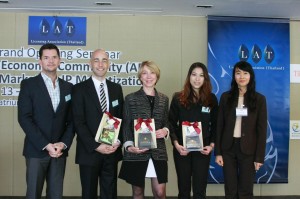 Slatebridge Restaurant Group, Inc. uses the brand, “SONOMA’S MARKET CALIFORNIA INSPIRED, LOCALLY PREPARED” and design on a variety of grab-and-go meals and food service items prepared under its Plaza Foodservice business, which has locations in the Kansas City and Denver areas.
Slatebridge Restaurant Group, Inc. uses the brand, “SONOMA’S MARKET CALIFORNIA INSPIRED, LOCALLY PREPARED” and design on a variety of grab-and-go meals and food service items prepared under its Plaza Foodservice business, which has locations in the Kansas City and Denver areas.
 Registration was refused on the grounds that the mark is geographically deceptive and geographically misdescriptive under Sections (e)(3) and 2(a) of the Lanham Act.
Registration was refused on the grounds that the mark is geographically deceptive and geographically misdescriptive under Sections (e)(3) and 2(a) of the Lanham Act.
The Examiner refused the application on the basis that Sonoma is a known location in California, that the goods do not originate in Sonoma and that purchasers would be likely to make a goods-place association and believe that the goods originated in California. The examiner believed the misrepresentation of geographic origin would be a material factor in consumers’ decision to buy the goods. As a basis for the refusal, the Examiner alleged that Sonoma is well known for produce generally and therefore consumers would be likely to believe that Slatebridge’s salads, sandwiches and other food items originated or contained ingredients from Sonoma, California.
Overcoming the Refusal
OLG demonstrated that the image used in the mark is a fictional artist rendering of a landscape and is not a picture of any actual location, including Sonoma.
OLG also established that the entirety of the mark suggests that the food reflects what is known as “California Cuisine” but does not indicate origin. Further, the phrase “Locally Prepared” would indicate to consumers in the Kansas City and Denver metro areas that the food items did not originate in California. Thus the mark when viewed as a whole conjures up memories or images of the California or the Sonoma region, but any such association falls short of a likelihood of a goods-place association in the minds of consumers.
OLG submitted numerous documents from the USDA, the California Department of Agriculture, agriculture reports for Sonoma County and California tourism sources to show that Sonoma is not well known for produce in general, but is known for wine. California produces substantial agricultural products, but the total crop value of fruits and vegetables from Sonoma is not significant as compared to the rest of the state and pales in comparison to Sonoma County’s yield of wine grapes.
Finally, OLG argued that this case is analogous to the 2003 Federal Circuit case In re Les Halles De Paris J.V., 334 F.3d 1371, 67 U.S.P.Q.2d 1539. In Les Halles, the Federal Circuit held that a restaurant patron would be fully aware that the source of restaurant services in a New York restaurant named “Le Marais” would not originate from the Parisian neighborhood of the same name. Likewise, due to the entire impression created by the mark, direct customers of the goods are fully aware of the local origin of the goods and are therefore not likely to be misled into making an erroneous goods-place association between the goods and Sonoma, California. Registration was allowed to proceed.
Case Takeaway
Trademark applicants must be cautious in using geographic terms in its trademarks, because there is a risk that the mark could be deemed merely descriptive (if the goods are correctly associated with the geographic area) or primarily misdescriptive and deceptively misdescriptive (if the goods do not originate from the geographic area). However, this case demonstrates that a geographic term may lend itself to a suggestive trademark that creates a strong brand image, capable of registration on the US Principle Register, without misleading consumers as to the source or nature of the goods or services.
Continue Reading









 The USPTO refused
The USPTO refused  In addition, OLG presented strong evidence in the form of news articles, dictionaries, and other publications that “cabrón” has a well-known colloquial meaning that is vulgar. In fact, CABRON brand tequila cannot be sold in Mexico due to this well-known secondary definition, despite the brand owner’s arguments that the primary meaning of the mark is “goat.”
In addition, OLG presented strong evidence in the form of news articles, dictionaries, and other publications that “cabrón” has a well-known colloquial meaning that is vulgar. In fact, CABRON brand tequila cannot be sold in Mexico due to this well-known secondary definition, despite the brand owner’s arguments that the primary meaning of the mark is “goat.” Early monitoring of trademark applications offers a strategic benefit in the United States compared to monitoring applications only upon publication. OLG offers global trademark application monitoring for its clients’ key brands and was able to flag and watch a US trademark application that conflicts with
Early monitoring of trademark applications offers a strategic benefit in the United States compared to monitoring applications only upon publication. OLG offers global trademark application monitoring for its clients’ key brands and was able to flag and watch a US trademark application that conflicts with 
 Registration was refused on the grounds that the mark is geographically deceptive and geographically misdescriptive under Sections (e)(3) and 2(a) of the Lanham Act.
Registration was refused on the grounds that the mark is geographically deceptive and geographically misdescriptive under Sections (e)(3) and 2(a) of the Lanham Act.


